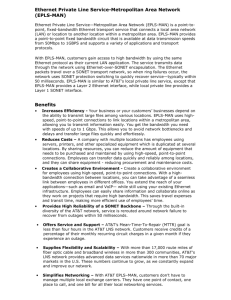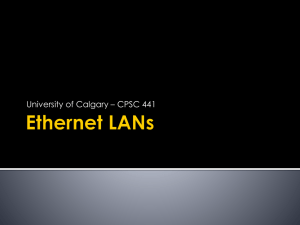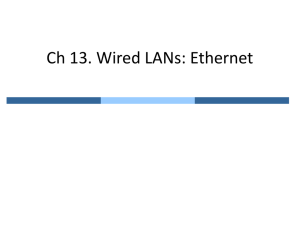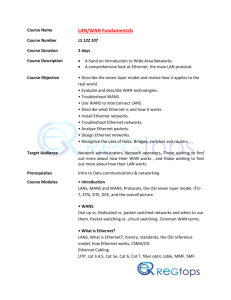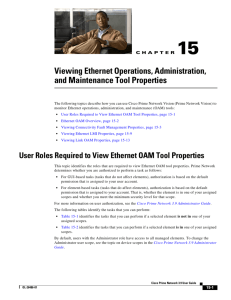Frame Loss Ratio, Frame Delay, Frame Delay
advertisement
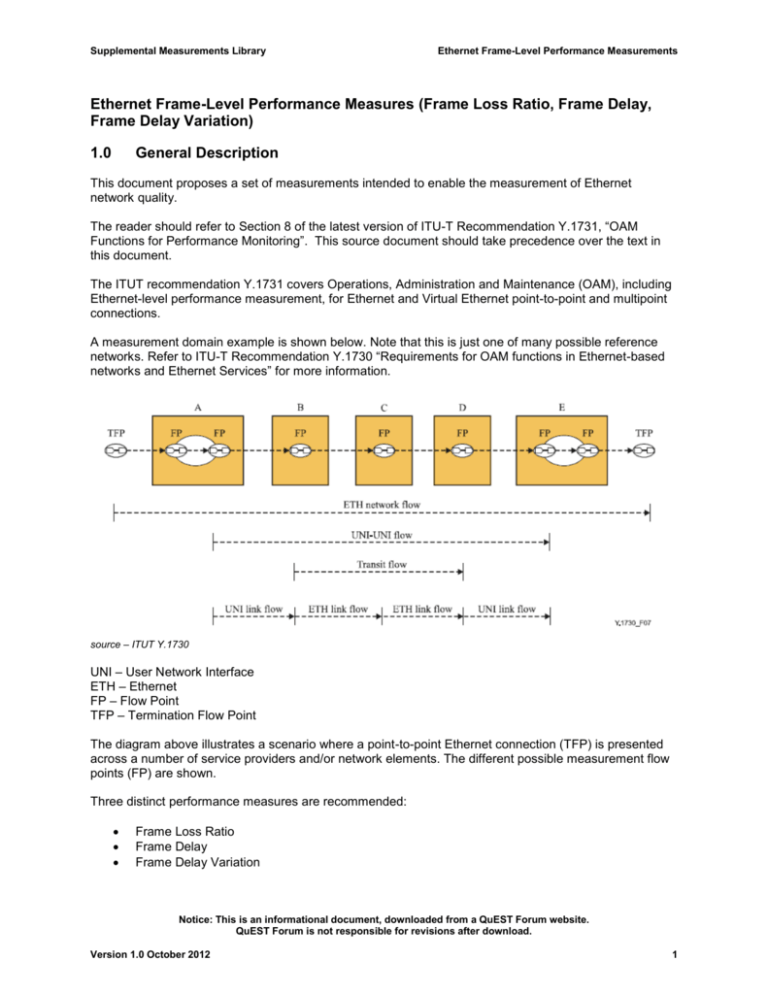
Supplemental Measurements Library Ethernet Frame-Level Performance Measurements Ethernet Frame-Level Performance Measures (Frame Loss Ratio, Frame Delay, Frame Delay Variation) 1.0 General Description This document proposes a set of measurements intended to enable the measurement of Ethernet network quality. The reader should refer to Section 8 of the latest version of ITU-T Recommendation Y.1731, “OAM Functions for Performance Monitoring”. This source document should take precedence over the text in this document. The ITUT recommendation Y.1731 covers Operations, Administration and Maintenance (OAM), including Ethernet-level performance measurement, for Ethernet and Virtual Ethernet point-to-point and multipoint connections. A measurement domain example is shown below. Note that this is just one of many possible reference networks. Refer to ITU-T Recommendation Y.1730 “Requirements for OAM functions in Ethernet-based networks and Ethernet Services” for more information. source – ITUT Y.1730 UNI – User Network Interface ETH – Ethernet FP – Flow Point TFP – Termination Flow Point The diagram above illustrates a scenario where a point-to-point Ethernet connection (TFP) is presented across a number of service providers and/or network elements. The different possible measurement flow points (FP) are shown. Three distinct performance measures are recommended: Frame Loss Ratio Frame Delay Frame Delay Variation Notice: This is an informational document, downloaded from a QuEST Forum website. QuEST Forum is not responsible for revisions after download. Version 1.0 October 2012 1 Supplemental Measurements Library Ethernet Frame-Level Performance Measurements 1.1 Frame Loss Ratio 1.1.1 General Description Frame loss ratio is defined as a ratio, expressed as a percentage, of the number of service frames not delivered divided by the total number of service frames during time interval T, where the number of service frames not delivered is the difference between the number of service frames arriving at the ingress ETH flow point and the number of service frames delivered at the egress ETH flow point in a point-to-point ETH connection. (source – ITUT Y.1731) 1.1.2 Purpose Frame Loss Ratio provides a measure of frame delivery reliability between two Ethernet endpoints either on a segment or end-to-end virtual Ethernet level. High Frame Loss Ratio may drive TCP or applicationlevel retransmission and so affect application performance or quality. 1.1.3 Applicable Product Categories This measurement applies to Switching (Access, Multi-Service and Routers) and Transport (Optical Switches and Transport Links). 1.1.4 Detailed Description Refer to the ITUT Y.1731 Recommendation document for a detailed description of this measure. 1.1.5 Sources of Data Organizations shall collect all data necessary to support this measurement. 1.2 Frame Delay 1.2.1 General Description Frame delay can be specified as round-trip delay for a frame, where frame delay is defined as the time elapsed since the start of transmission of the first bit of the frame by a source node until the reception of the last bit of the loopbacked frame by the same source node, when the loopback is performed at the frame's destination node. (source – ITUT Y.1731) One-way frame delay is possible only if both endpoints are synched to a common clock source. 1.2.2 Purpose Frame Delay provides a measure of frame delivery latency between two Ethernet endpoints either on a segment or end-to-end virtual Ethernet level. Excessive Frame Delay may be an early indicator of detriment to, as an example, voice and data transfer applications. 1.2.3 Applicable Product Categories This measurement applies to Switching (Access, Multi-Service and Routers) and Transport (Optical Switches and Transport Links). 1.2.4 Detailed Description Notice: This is an informational document, downloaded from a QuEST Forum website. QuEST Forum is not responsible for revisions after download. Version 1.0 October 2012 2 Supplemental Measurements Library Ethernet Frame-Level Performance Measurements Refer to the ITUT Y.1731 Recommendation document for a detailed description of this measure. 1.2.5 Sources of Data Organizations shall collect all data necessary to support this measurement. 1.3 Frame Delay Variation 1.3.1 General Description Frame delay variation is a measure of the variations in the frame delay between a pair of service frames, where the service frames belong to the same CoS instance on a point-to-point ETH connection. (source – ITUT Y.1731) One-way frame delay is preferred for this measure and supported without a common clock as calculation is based on frame timestamps. 1.3.2 Purpose Frame Delay Variation provides a measure of frame delivery consistency between two Ethernet endpoints either on a segment or end-to-end virtual Ethernet level. Excessive Frame Delay may be an early indicator of detriment for, as an example, video applications. 1.3.3 Applicable Product Categories This measurement applies to Switching (Access, Multi-Service and Routers) and Transport (Optical Switches and Transport Links). 1.3.4 Detailed Description Refer to the ITUT Y.1731 Recommendation document for a detailed description of this measure. 1.3.5 Sources of Data Organizations shall collect all data necessary to support this measurement. Notice: This is an informational document, downloaded from a QuEST Forum website. QuEST Forum is not responsible for revisions after download. Version 1.0 October 2012 3

